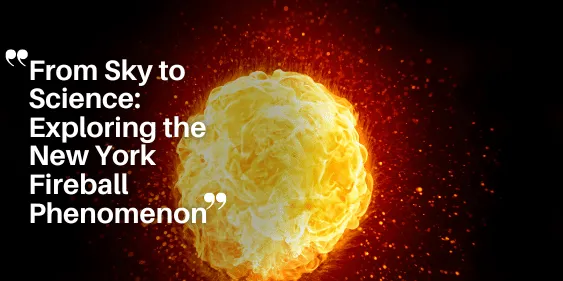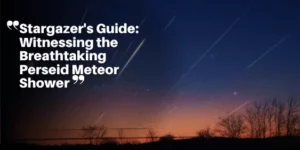From Sky to Science: Exploring the New York Fireball Phenomenon

A daytime fireball blazed across the sky over the New York metropolitan area, commanding the attention of numerous East Coast residents on Tuesday morning.
Remarkably visible in broad daylight, this meteor turned heads and sparked curiosity far and wide.
Residents of New York City and other nearby states were captivated as the fireball streaked overhead, making its way southwest before disintegrating approximately 31 miles (50 kilometers) above Mountainside, New Jersey.
This event wasn’t your run-of-the-mill shooting star; the fireball, estimated to be about 1 foot (0.3 meters) in diameter, was clearly discernible against the bright morning sky, a rarity in the world of meteors.
Fireballs of this nature often contribute to an increased interest in astronomy and skygazing.
The sheer spectacle of the meteor’s journey across the sky provided an unexpected midday show, leaving many witnesses eager for more celestial events.
This wider public enthusiasm sets the stage perfectly for upcoming meteor viewing opportunities in the weeks ahead.
Characteristics and Trajectory
The recent daytime fireball that captivated residents across the New York metropolitan area was estimated to be about 1 foot (0.3 meters) in diameter.
Such a size is sufficient to make it visible during daylight, which is an uncommon but spectacular occurrence.
The meteor made its dramatic appearance in the sky over New York City and journeyed southwest, eventually traversing to Mountainside, New Jersey.
What makes this event even more remarkable is the way the fireball met its end. It disintegrated approximately 31 miles (50 kilometers) above Mountainside, New Jersey.
According to Bill Cooke from NASA’s Meteoroid Environment Office, disintegration at this altitude means that the meteor likely created a vivid display in the sky before burning up completely.
This specific trajectory — from New York City to Mountainside — provides fascinating insights into the flight path and final moments of the fireball.
While it lit up the sky, it also prompted widespread interest in celestial events. This rare event reminds us of the constant dynamic interactions between Earth and outer space.
As we delve deeper into these meteoric occurrences, it’s clear that celestial events continue to intrigue and inspire, providing ample opportunities for learning and observation.
Witness Accounts and Documentation
The New York fireball event captivated many, with numerous reports pouring into the American Meteor Society.
Sightings were registered from across several Northeastern states, including New York, New Jersey, and Connecticut.
The intriguing aspect of these reports is the consistency in the observations, which provided a solid foundation for scientific analysis.
Multiple Reports and Confirmed Videos
Two critical pieces of evidence have significantly contributed to validating the fireball sighting.
The first video originated from a home security camera in Wayne, New Jersey, while the second came from a meteor-specific camera stationed in Northford, Connecticut.
These videos unequivocally captured the fireball’s swift transit across the daytime sky, offering vital visual documentation for study.
Sensory Experiences of Witnesses
Incidents like these aren’t just visual spectacles.
Several witnesses reported hearing loud sonic booms and feeling the ground shake.
These sensory experiences are usually linked to the meteor’s breakup as it enters the atmosphere, creating a pressure wave.
However, NASA could not confirm that these sounds and vibrations were directly caused by the meteor, citing limitations such as infrasound detectors being influenced by simultaneous military activity in the region.
Transition to Further Scientific Analysis
Captured by both home and meteor cameras and reported extensively by witnesses, these documented experiences provide a rich dataset for understanding such rare daytime phenomena.
This robust documentation lays the groundwork for more in-depth scientific analysis and understanding of the event’s impacts.
Scientific Analysis
NASA’s Involvement
The unexpected daytime fireball over New York captured significant public and scientific interest.
NASA’s Meteoroid Environment Office took the lead in investigating the event, leveraging advanced analytical tools and methodologies to understand its characteristics.
This analysis is critical for interpreting the phenomenon and contributing to meteor science.
Sonic Boom and Pressure Wave
One of the key aspects analyzed was the possibility of a sonic boom and pressure wave resulting from the meteor’s breakup.
The distinct loud noise and ground vibrations reported by witnesses align with common outcomes when a meteor disintegrates in the atmosphere.
Such breakups occur because of the intense heat and pressure experienced as the meteoroid passes through the lower atmosphere.
This can generate a strong shockwave — a sonic boom — that can be heard and felt over a wide area.
Meteorite Production
Despite the dramatic breakup, experts have determined that the fireball likely did not produce meteorites.
Bill Cooke from NASA cited the fireball’s size and speed as reasons for this.
The one-foot diameter object moving at high velocity likely disintegrated fully in the atmosphere, leaving no fragments to reach the Earth’s surface.
This finding is consistent with the characteristics of most daylight fireballs, which, due to their smaller size and faster travel, seldom produce meteorites.
Implications
The scientific inquiry into this event enriches our understanding of meteoric phenomena.
Daytime fireballs are rare, and thorough analyses like this help in improving detection and predictive models.
The detailed study by NASA’s Meteoroid Environment Office adds a valuable data point to ongoing research, aiding future observations and enhancing public awareness about celestial events.
Coming up, the sky will offer more opportunities for potential fireball sightings, thanks to impending meteor showers.
Rarity and Timing
Daytime fireballs are indeed a rare sight, making their unexpected appearance a thrilling experience for many sky-gazers.
These luminous meteors, bright enough to be seen against the backdrop of the sunlit sky, occur approximately once a year.
This rarity only adds to the excitement and awe they inspire among those lucky enough to witness them.
The recent event over the New York metropolitan area was a standout moment for residents.
The last time a similar phenomenon graced the area was about a year and a half ago.
This recent fireball was captivating not just due to its brightness but also its impeccable timing.
It appeared around midday when people were engaged in their typical lunchtime routines.
The timing ensured that a significant number of individuals were outdoors, further amplified by the fact that it was broad daylight, a period usually devoid of visible meteors.
This ideal timing translated into widespread observations and excitement, fostering a renewed interest in celestial events.
It provided an unexpected, yet delightful distraction from the everyday hustle, reminding us of the endless wonders of our universe.
The midday timing of the fireball significantly contributed to the volume of reports and documentation, maximizing its impact and reach.
Future Skywatching Opportunities
Upcoming Meteor Showers
For those looking to witness more celestial wonders, the next few weeks promise exciting opportunities.
The Southern Delta Aquariids are set to peak at the end of July, potentially gifting viewers with about 20 meteors per hour.
This meteor shower, although less known, offers a serene experience for those venturing out during the late-night hours.
Following closely behind, the Perseids will peak in mid-August.
Regarded as one of the most popular meteor showers, the Perseids can deliver upwards of 100 meteors per hour.
Their bright and colorful streaks often provide a dazzling show, captivating audiences year after year.
Potential for More Fireballs
With such vibrant meteor showers on the horizon, there’s also a chance to spot more fireballs.
As remnants of comets or asteroids enter Earth’s atmosphere, they can produce spectacular light displays.
While daytime fireballs like the one recently seen are rare, the coming weeks’ night skies might still feature these brilliant phenomena, adding to the nocturnal allure.
Growing Public Interest
The recent daytime fireball over the New York metropolitan area has sparked renewed public interest in sky-gazing.
People’s curiosity about these events is a perfect gateway to deepen their appreciation of astronomy.
From casual observers to dedicated hobbyists, there’s a growing crowd eager to catch glimpses of the universe’s wonders.
These upcoming meteor showers not only offer a visual treat but also provide fertile ground for educational moments about our celestial surroundings.
Keep your eyes on the skies; there’s no telling what wonders you’ll witness next!







